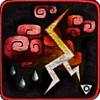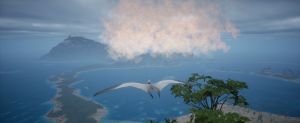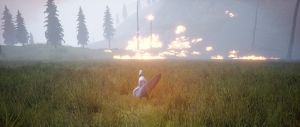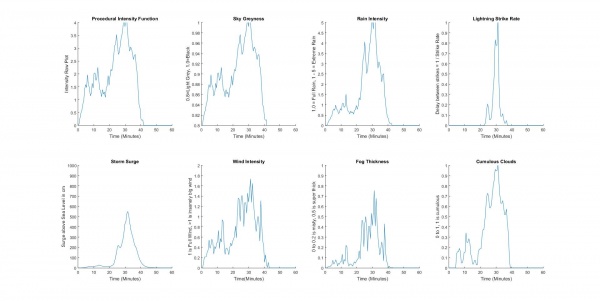Difference between revisions of "Weather"
m |
(Rewrote the article, making it with more diluted information. Added images and re-arrange it. Added missing or outdated information. Natural disasters and Weather are now on 1 page toghether. STILL FINAL NEEDS REVISION.) |
||
| Line 1: | Line 1: | ||
== Overview == | == Overview == | ||
| + | The climate of the Bermuda Islands can be unforgivable. The weather and natural disasters you will face in Beasts of Bermuda are challenging, affecting your creature [[Comfort|comfort]] and even inflicting harsh damage. Be ready to endure ''tornados'', ''forest fires'', ''heavy storms'', ''floods'' or even ''droughts''. All of it, unless forced by a console command, is randomized and can come in different; durations, combinations, and intensity levels, making these events unpredictable. | ||
| + | = Weather = | ||
| + | === '''Storms''' === | ||
| + | [[File:The Elements.png |left|100px|border|thumb| Debuff "The Elements"]] | ||
| + | Light rains can play a major role in survival, keeping creatures hydrated and refreshing [[Water|dirty]] water pounds or depleted [[Freshwater Lakes|freshwater resources]]. However, during heavy storms, players must seek [[shelter]] to prevent comfort loss and therefore damage. The [[Talent tree|Weather Resistance]] talent can help players mitigate [[Comfort|comfort]] loss during storms, though certain playables are by default, more resistant to the weather conditions than others. If your creature is stressed due to the storm, the debuff icon "The Elements" will appear on the right top of your screen. <br><br> | ||
| + | [[File:Enhanced_Growth.png|right|100px|border|thumb| Buff "Enchanced Growth"]] | ||
| + | In some cases, a heavy storm can become a '''"Growth Storm"''', a more harsh but rewarding kind of tempest where [[Status Effects|Enhanced Growth]] is given to all players. During '''Growth Storms''' creatures do not cause intimidation to each other, even if not grouped. <br><br> | ||
| + | <br><br> | ||
| + | === '''Lightning''' === | ||
| + | [[File:719890 screenshots 20180924081210 1.jpg|right400px|border|thumb|A [[Pteranodon]] weathering an intense thunderstorm.]] | ||
| + | Lightning bolts will spawn periodically during an existing '''storm '''or on a '''dry storm''', The more intense the storm, the more frequent the lightning will occur. Lightning has a chance to target and strike an [[Shelter|unsheltered]] player giving a high amount of damage. Most creatures die when struck by a lightning bolt but whether you survive will depend only on the creature's '''size '''and '''health pool.''' With 3/3 points invested in the talent [[Talent tree|Weather Resistance]] it will prevent death by lightning strikes.<br><br> | ||
| + | Lightning does not strike [[Aquatic Creatures|aquatic creatures]], regardless of whether they're sheltered, unless they are [[Beaching|beached]]. <br><br> | ||
| + | '''Dry storms''' can also cause Forest Fires <br><br> | ||
| + | = Natural Disasters = | ||
| + | === '''Forest Fires''' === | ||
| + | [[File:SmokeStack.jpg|right|300px|border|thumb|A Tropeognathus noticing an active fire from Dry Lightning.]] | ||
| + | [[File:ActiveFire.jpg|left|300px|border|thumb|A Tropeognathus watches as the fire scorches the area.]] | ||
| + | Wildfires spread quickly and are deadly. When a fire is spawned, it will propagate across the terrain, spreading to close vegetation. The fire will continue burning until it cannot find suitable vegetation to propagate to. The larger the fire, the further its reach, so large flames can jump from tree to tree, whereas a small fire may only be able to ignite other plants right beside it. '''Players who are close enough from the flames may'''; '''get lit up''' [[Status Effects|on fire]], giving peridocily damage for 10 seconds. '''Suffer from the debuff''' [[Status Effects | "Stressful Scene"]] that greatly lowers a creature's comfort level or '''die of asphyxiation''' if inside of a cave or if the player gets surrounded by fire. Some talents like [[Talent tree | Stress resistance]] or [[Talent tree | Strong Lungs]] can help mitigate some of these dangers. Fires will also burn down avaliable food for herbivores diet. <br><br> | ||
| + | Fires produce columns of smoke, which can be seen from great distances. This allows players to locate and avoid fires.<br><br> | ||
| + | When a fire spawns, its dangers do not immediately kick into effect. There is a 10-second grace period between spawn and activation, allowing players a window to escape if a forest fire spawns in extreme proximity to them. If an existing creature spawn point is close to or within a forest fire the user will be warned of fires near the specific creature's spawn location and will be given the option to continue or cancel the action of logging in. <br><br> | ||
| + | |||
| + | === '''Tornadoes''' === | ||
| + | [[File:719890 screenshots 20181003103746 1.jpg|right400px|border|thumb| An [[Apatosaurus]] trying to stay comfortable during a storm with two tornadoes in the background.]] | ||
| + | Tornadoes can spawn during an existing '''storm ''' or on a '''wind storm''', commonly before a tornado appears is noticeable a heavy fog and vegetation violently swing with the wind, as well as a strong windy sound. Tornadoes can pick up every type of creature and chuck them across the map. The heavier a creature is the lower a tornado can carry it, sometimes it won't be able to lift it at all, for example an '''adult''' [[apatosaurus]] wouldn't be lifted. Tornadoes will track and follow the nearest terrestrial creature. If the tracked creature dies, swims underwater, flies away, or rests under 100% shelter, the tornado will abandon the target and seek the next closest terrestrial creature. Tornadoes tend to track the largest concentration of unsheltered players on the map. <br><br> | ||
| + | The only way to avoid a tornado is by getting 100% [[shelter]], if you are below 100% you may still be carried away. <br><br> | ||
| + | === '''Floods''' === | ||
| + | Floods can only occur during '''heavy storms''', swiftly raising the tide dramatically. Beware of caves since they can quickly flood entirely. Floods can also make terrestrial creatures move higher up to mountains or cross already-flooded areas in search of land to stay on. It also gives a great opportunity for aquatic beasts to take advantage of the situation. | ||
| + | === '''Droughts''' === | ||
| + | As for right now, droughts naturally occur by the player base of the server. Players can drink water from a [[Freshwater Lakes|lakes and pounds]] until is completely dry, if too many players deplete water sources and no rain occurs available water sources can become extremely limited. | ||
| + | == Extiction Event == | ||
| + | An '''"Extinction Event"''' is what the player base calls an extreme and rare case of events. In an extinction event all of the natural disasters will occur at the same time at an extreme intensity level, you can tell when an extinction event is occurring when by the end of it the whole map is covered by an enormous flood, leaving little to no chance of survival. This event is pretty rare and not all players are able to see it with their own eyes. <br><br> | ||
| + | An extinction event can even build up and carry on for more than 30 minutes*. <br><br> | ||
| + | /* This is just an estimate. <br><br> | ||
| + | = How Weather is Generated = | ||
| + | [[File:LargeStorm1.jpg|right|thumb|600px|border|MATLAB Generated Storm Simulation for Beasts of Bermuda]] | ||
| + | A development blog post was written on how storms are generated [https://beastsofbermuda.com/blog/post/procedural-weather/ here]. | ||
| + | |||
| + | The storm generator works essentially by throwing weighted dice every 36 seconds while the storm event is occurring. These dice dictate the storm's intensity profile, passing through four intervals of randomly determined duration. The tuning of the storm generator for creation in the UE4 engine was actually done using a MATLAB script with a wide array of parameters that determine many elements of the storm. A profile of a severe storm is shown on this wiki page, in which one can see all the different storm elements. Some of these elements are purely aesthetic, whereas others have gameplay repercussions. | ||
| + | |||
| + | The first stage of any generated storm is set up with a set of dice rolls that unanimously will increase the storm intensity. The amount of rolls is randomly determined. This ensures that no storm will peter out after only a few ticks of the storm clock, granting every storm a minimum threshold. Some storms will die immediately after this interval, causing weather events as short as 3 minutes. | ||
| + | |||
| + | In the second stage of the storm, the dice are biased towards increases in intensity but decreases are possible, thus allowing the moderately rare, super short storm to die here. As biased rolls of these dice accumulate, it is likely (but not guaranteed) that the storm will increase in intensity profile. | ||
| + | |||
| + | The third stage of the storm grants fair chance to the storm generator to increase or decrease in severity. In some instances, this may lead to continued increases in storm severity to ridiculous levels, often following suit with extreme storm surges that can flood significant sections of the game world. In other instances, the storm will die here, never making it to stage four. On average, the storm will stay relatively even in intensity profile. This stage of storm generation can vary in time duration from very brief, to rather long periods of time. | ||
| + | |||
| + | The fourth stage of the storm is marked by inevitable death. The storm will die, as in this stage with each cast of the dice that dictate the storm intensity profile, the likelihood of the roll coming out positive is lower and lower. A storm can occasionally resist stage four storm killing for a while, but eventually will be brought down. | ||
| + | |||
| + | It is also noteworthy to explain that the time duration between storms is randomly dictated. Storms can strike nearly back to back, or a significant amount of time can pass between two storms. | ||
| + | = '''The above is up-to-date. Below this point are the outdated remains of this article.''' = | ||
| + | Press "Show" to check the old article version. (Only temporalily) <br><br> | ||
| + | <div class="mw-collapsible mw-collapsed" data-expandtext="{{int:show}}" data-collapsetext="{{int:hide}}"> | ||
| + | |||
| + | |||
| + | == Overview == | ||
| + | |||
| + | |||
| + | <!--- OLD VERSION OF THE ARTICLE! PLEASE IF YOU WANT TO EDIT IT SOMETHING DO NOT GO BELOW HERE ---- !> | ||
| + | |||
A significant and antagonistic element of survival in Beasts of Bermuda is enduring the effects of storms. The weather generator in Beasts of Bermuda is capable of generating many different types of storms, with many different intensities and durations. The intensity of the storm along with its shape over time will dictate several different elements such as rain, storm surges, wind, and lightning. Due to the way in which it is programmed, almost any storm is possible, but some variants are significantly less probable than others. Many weather events will not be intense enough to cause significant threat to survival, often generating gentle or moderate amounts of rain with little to no storm surge. Occasionally, however, a full-force hurricane will hit, presenting a very significant threat to survival. | A significant and antagonistic element of survival in Beasts of Bermuda is enduring the effects of storms. The weather generator in Beasts of Bermuda is capable of generating many different types of storms, with many different intensities and durations. The intensity of the storm along with its shape over time will dictate several different elements such as rain, storm surges, wind, and lightning. Due to the way in which it is programmed, almost any storm is possible, but some variants are significantly less probable than others. Many weather events will not be intense enough to cause significant threat to survival, often generating gentle or moderate amounts of rain with little to no storm surge. Occasionally, however, a full-force hurricane will hit, presenting a very significant threat to survival. | ||
| Line 70: | Line 128: | ||
See also: [[Natural Disasters]] | See also: [[Natural Disasters]] | ||
| + | </div> | ||
Latest revision as of 21:04, 12 September 2024
Contents
Overview
The climate of the Bermuda Islands can be unforgivable. The weather and natural disasters you will face in Beasts of Bermuda are challenging, affecting your creature comfort and even inflicting harsh damage. Be ready to endure tornados, forest fires, heavy storms, floods or even droughts. All of it, unless forced by a console command, is randomized and can come in different; durations, combinations, and intensity levels, making these events unpredictable.
Weather
Storms
Light rains can play a major role in survival, keeping creatures hydrated and refreshing dirty water pounds or depleted freshwater resources. However, during heavy storms, players must seek shelter to prevent comfort loss and therefore damage. The Weather Resistance talent can help players mitigate comfort loss during storms, though certain playables are by default, more resistant to the weather conditions than others. If your creature is stressed due to the storm, the debuff icon "The Elements" will appear on the right top of your screen.
In some cases, a heavy storm can become a "Growth Storm", a more harsh but rewarding kind of tempest where Enhanced Growth is given to all players. During Growth Storms creatures do not cause intimidation to each other, even if not grouped.
Lightning
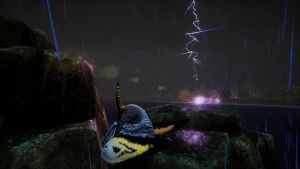
Lightning bolts will spawn periodically during an existing storm or on a dry storm, The more intense the storm, the more frequent the lightning will occur. Lightning has a chance to target and strike an unsheltered player giving a high amount of damage. Most creatures die when struck by a lightning bolt but whether you survive will depend only on the creature's size and health pool. With 3/3 points invested in the talent Weather Resistance it will prevent death by lightning strikes.
Lightning does not strike aquatic creatures, regardless of whether they're sheltered, unless they are beached.
Dry storms can also cause Forest Fires
Natural Disasters
Forest Fires
Wildfires spread quickly and are deadly. When a fire is spawned, it will propagate across the terrain, spreading to close vegetation. The fire will continue burning until it cannot find suitable vegetation to propagate to. The larger the fire, the further its reach, so large flames can jump from tree to tree, whereas a small fire may only be able to ignite other plants right beside it. Players who are close enough from the flames may; get lit up on fire, giving peridocily damage for 10 seconds. Suffer from the debuff "Stressful Scene" that greatly lowers a creature's comfort level or die of asphyxiation if inside of a cave or if the player gets surrounded by fire. Some talents like Stress resistance or Strong Lungs can help mitigate some of these dangers. Fires will also burn down avaliable food for herbivores diet.
Fires produce columns of smoke, which can be seen from great distances. This allows players to locate and avoid fires.
When a fire spawns, its dangers do not immediately kick into effect. There is a 10-second grace period between spawn and activation, allowing players a window to escape if a forest fire spawns in extreme proximity to them. If an existing creature spawn point is close to or within a forest fire the user will be warned of fires near the specific creature's spawn location and will be given the option to continue or cancel the action of logging in.
Tornadoes
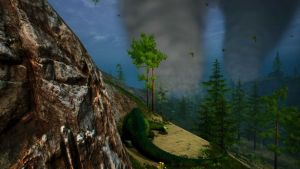
Tornadoes can spawn during an existing storm or on a wind storm, commonly before a tornado appears is noticeable a heavy fog and vegetation violently swing with the wind, as well as a strong windy sound. Tornadoes can pick up every type of creature and chuck them across the map. The heavier a creature is the lower a tornado can carry it, sometimes it won't be able to lift it at all, for example an adult apatosaurus wouldn't be lifted. Tornadoes will track and follow the nearest terrestrial creature. If the tracked creature dies, swims underwater, flies away, or rests under 100% shelter, the tornado will abandon the target and seek the next closest terrestrial creature. Tornadoes tend to track the largest concentration of unsheltered players on the map.
The only way to avoid a tornado is by getting 100% shelter, if you are below 100% you may still be carried away.
Floods
Floods can only occur during heavy storms, swiftly raising the tide dramatically. Beware of caves since they can quickly flood entirely. Floods can also make terrestrial creatures move higher up to mountains or cross already-flooded areas in search of land to stay on. It also gives a great opportunity for aquatic beasts to take advantage of the situation.
Droughts
As for right now, droughts naturally occur by the player base of the server. Players can drink water from a lakes and pounds until is completely dry, if too many players deplete water sources and no rain occurs available water sources can become extremely limited.
Extiction Event
An "Extinction Event" is what the player base calls an extreme and rare case of events. In an extinction event all of the natural disasters will occur at the same time at an extreme intensity level, you can tell when an extinction event is occurring when by the end of it the whole map is covered by an enormous flood, leaving little to no chance of survival. This event is pretty rare and not all players are able to see it with their own eyes.
An extinction event can even build up and carry on for more than 30 minutes*.
/* This is just an estimate.
How Weather is Generated
A development blog post was written on how storms are generated here.
The storm generator works essentially by throwing weighted dice every 36 seconds while the storm event is occurring. These dice dictate the storm's intensity profile, passing through four intervals of randomly determined duration. The tuning of the storm generator for creation in the UE4 engine was actually done using a MATLAB script with a wide array of parameters that determine many elements of the storm. A profile of a severe storm is shown on this wiki page, in which one can see all the different storm elements. Some of these elements are purely aesthetic, whereas others have gameplay repercussions.
The first stage of any generated storm is set up with a set of dice rolls that unanimously will increase the storm intensity. The amount of rolls is randomly determined. This ensures that no storm will peter out after only a few ticks of the storm clock, granting every storm a minimum threshold. Some storms will die immediately after this interval, causing weather events as short as 3 minutes.
In the second stage of the storm, the dice are biased towards increases in intensity but decreases are possible, thus allowing the moderately rare, super short storm to die here. As biased rolls of these dice accumulate, it is likely (but not guaranteed) that the storm will increase in intensity profile.
The third stage of the storm grants fair chance to the storm generator to increase or decrease in severity. In some instances, this may lead to continued increases in storm severity to ridiculous levels, often following suit with extreme storm surges that can flood significant sections of the game world. In other instances, the storm will die here, never making it to stage four. On average, the storm will stay relatively even in intensity profile. This stage of storm generation can vary in time duration from very brief, to rather long periods of time.
The fourth stage of the storm is marked by inevitable death. The storm will die, as in this stage with each cast of the dice that dictate the storm intensity profile, the likelihood of the roll coming out positive is lower and lower. A storm can occasionally resist stage four storm killing for a while, but eventually will be brought down.
It is also noteworthy to explain that the time duration between storms is randomly dictated. Storms can strike nearly back to back, or a significant amount of time can pass between two storms.
The above is up-to-date. Below this point are the outdated remains of this article.
Press "Show" to check the old article version. (Only temporalily)
